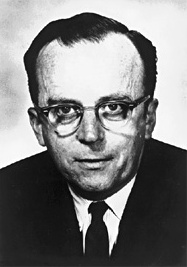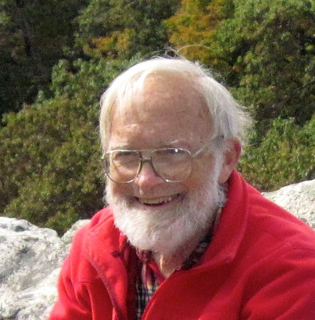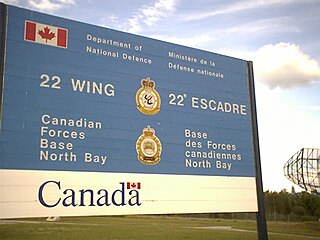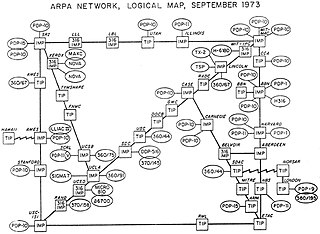Related Research Articles

The Defense Advanced Research Projects Agency (DARPA) is a research and development agency of the United States Department of Defense responsible for the development of emerging technologies for use by the military.

Stephen D. Crocker is an Internet pioneer. In 1969, he created the ARPA "Networking Working Group" and the Request for Comments series. He served as chair of the board of the Internet Corporation for Assigned Names and Numbers (ICANN) from 2011 through 2017.

Ivan Edward Sutherland is an American computer scientist and Internet pioneer, widely regarded as a pioneer of computer graphics. His early work in computer graphics as well as his teaching with David C. Evans in that subject at the University of Utah in the 1970s was pioneering in the field. Sutherland, Evans, and their students from that era developed several foundations of modern computer graphics. He received the Turing Award from the Association for Computing Machinery in 1988 for the invention of the Sketchpad, an early predecessor to the sort of graphical user interface that has become ubiquitous in personal computers. He is a member of the National Academy of Engineering, as well as the National Academy of Sciences among many other major awards. In 2012, he was awarded the Kyoto Prize in Advanced Technology for "pioneering achievements in the development of computer graphics and interactive interfaces".

Raytheon BBN is an American research and development company, based next to Fresh Pond in Cambridge, Massachusetts, United States.

The Advanced Research Projects Agency Network (ARPANET) was the first wide-area packet-switched network with distributed control and one of the first networks to implement the TCP/IP protocol suite. Both technologies became the technical foundation of the Internet. The ARPANET was established by the Advanced Research Projects Agency (ARPA) of the United States Department of Defense.

Joseph Carl Robnett Licklider, known simply as J. C. R. or "Lick", was an American psychologist and computer scientist who is considered to be among the most prominent figures in computer science development and general computing history.

William Crowther is an American computer programmer, caver, and rock climber. He is the co-creator of Colossal Cave Adventure from 1975 onward, a seminal computer game that influenced the first decade of video game design and inspired the text adventure game genre.

Robert William Taylor, known as Bob Taylor, was an American Internet pioneer, who led teams that made major contributions to the personal computer, and other related technologies. He was director of ARPA's Information Processing Techniques Office from 1965 through 1969, founder and later manager of Xerox PARC's Computer Science Laboratory from 1970 through 1983, and founder and manager of Digital Equipment Corporation's Systems Research Center until 1996.
SRI International's Augmentation Research Center (ARC) was founded in the 1960s by electrical engineer Douglas Engelbart to develop and experiment with new tools and techniques for collaboration and information processing.
System Development Corporation (SDC) was a computer software company based in Santa Monica, California. Founded in 1955, it is considered the first company of its kind.

Intergalactic Computer Network or Galactic Network (IGCN) was a computer networking concept similar to today's Internet.

Wallace "Wally" Feurzeig was an American computer scientist who was co-inventor, with Seymour Papert and Cynthia Solomon, of the programming language Logo, and a well-known researcher in artificial intelligence (AI).

The Interface Message Processor (IMP) was the packet switching node used to interconnect participant networks to the ARPANET from the late 1960s to 1989. It was the first generation of gateways, which are known today as routers. An IMP was a ruggedized Honeywell DDP-516 minicomputer with special-purpose interfaces and software. In later years the IMPs were made from the non-ruggedized Honeywell 316 which could handle two-thirds of the communication traffic at approximately one-half the cost. An IMP requires the connection to a host computer via a special bit-serial interface, defined in BBN Report 1822. The IMP software and the ARPA network communications protocol running on the IMPs was discussed in RFC 1, the first of a series of standardization documents published by what later became the Internet Engineering Task Force (IETF).

Lawrence Gilman Roberts was an American engineer who received the Draper Prize in 2001 "for the development of the Internet", and the Principe de Asturias Award in 2002.

The AN/FSQ-32 SAGE Solid State Computer was a planned military computer central for deployment to Super Combat Centers in nuclear bunkers and to some above-ground military installations. In 1958, Air Defense Command planned to acquire 13 Q-32 centrals for several Air Divisions/Sectors.
Jack P. Ruina was an American electrical engineer who was a professor of electrical engineering at the Massachusetts Institute of Technology (MIT) from 1963 until 1997 and thereafter an MIT professor emeritus. From 1966 to 1970, he was also vice president for special laboratories at MIT.
The first International Conference on Computer Communications was held October 24–26, 1972 in Washington, DC at the Hilton Washington. It was organized by BBN Technologies under the direction of Bob Kahn and was one of the first public demonstrations of computer networking technology and functionality as well as products of the ARPANET project.

Frank Evans Heart was an American computer engineer influential in computer networking. After nearly 15 years working for MIT Lincoln Laboratory, Heart worked for Bolt, Beranek and Newman from 1966 to 1994, during which he led a team that designed the first routing computer for the ARPANET, the predecessor to the Internet.

SATNET, also known as the Atlantic Packet Satellite Network, was an early satellite network that formed an initial segment of the Internet. It was implemented by BBN Technologies under the direction of the Advanced Research Projects Agency.
References
- ↑ Lyon, Matthew; Hafner, Katie (1999-08-19). Where Wizards Stay Up Late: The Origins Of The Internet (p. 39). Simon & Schuster. Kindle Edition.
- ↑ The Advanced Research Projects Agency, 1958-1974 , Barber Associates, December 1975, pages V-49 to V-50.
- ↑ "Defense Advanced Research Projects Agency (DARPA) (United States Government)". Encyclopædia Britannica. Encyclopædia Britannica, Inc. Retrieved 11 January 2014.
- ↑ Garreau, Joel (2006). Radical Evolution: The Promise and Peril of Enhancing Our Minds, Our Bodies--and what it Means to be Human. Broadway. p. 22. ISBN 978-0-7679-1503-8.
- ↑ Barber Associates, op cit., page V-51.
- ↑ Barber Associates, op cit., page V-52.
- ↑ Moschovitis Group; Hilary W. Poole; Laura Lambert; Chris Woodford; Christos J. P. Moschovitis (2005). The Internet: A Historical Encyclopedia. ABC-CLIO. ISBN 1-85109-659-0.
- ↑ Page, Dan; Cynthia Lee (1999). "Looking Back at Start of a Revolution". UCLA Today. The Regents of the University of California (UC Regents). Archived from the original on 2007-12-24. Retrieved 2007-11-03.
- ↑ "He joined ARPA in early 1965, following Licklider’s departure, to work as deputy to Ivan Sutherland, IPTO’s second director. Months later, in 1966, at the age of thirty-four, Taylor became the third director of IPTO" Lyon, Matthew; Hafner, Katie (1999-08-19). Where Wizards Stay Up Late: The Origins Of The Internet (p. 40). Simon & Schuster. Kindle Edition.
- 1 2 "Massachusetts Institute of Technology in Cambridge. A Model 33 Teletype terminal, resembling a metal desk with a large noisy typewriter embedded in it, was linked to a computer at the University of California in Berkeley. And another Teletype terminal , a Model 35, was dedicated to a computer in Santa Monica, California, called, cryptically enough, the AN/ FSQ 32XD1A, nicknamed the Q-32," Lyon, Matthew; Hafner, Katie (1999-08-19). Where Wizards Stay Up Late: The Origins Of The Internet (p. 12). Simon & Schuster. Kindle Edition.
- ↑ Lyon, Matthew; Hafner, Katie (1999-08-19). Where Wizards Stay Up Late: The Origins Of The Internet (p. 13). Simon & Schuster. Kindle Edition.
- ↑ "Most of IPTO’s $ 19 million budget was being sent to campus laboratories in Boston and Cambridge, or out to California, to support work that held the promise of making revolutionary advances in computing." Lyon, Matthew; Hafner, Katie (1999-08-19). Where Wizards Stay Up Late: The Origins Of The Internet (p. 13). Simon & Schuster. Kindle Edition.
- ↑ "a shy, deep-thinking young computer scientist from the Lincoln Labs breeding ground named Larry Roberts." Lyon, Matthew; Hafner, Katie (1999-08-19). Where Wizards Stay Up Late: The Origins Of The Internet (p. 45). Simon & Schuster. Kindle Edition.
Sources
- Norberg, Arthur Lawrence; O'Neill, Judy Elizabeth; Freedman, Kerry J. (1996). Transforming Computer Technology: Information Processing for the Pentagon, 1962-1986. Johns Hopkins University Press. ISBN 978-0-8018-5152-0.